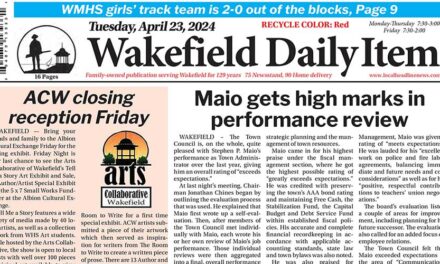Published in the December 9, 2015 edition
By MARK SARDELLA
WAKEFIELD — Local students who took the Common Core-aligned PARCC test last spring scored at similar levels as students in the rest of the state, according to new Assistant Superintendent of Schools Douglas Lyons.
Lyons reviewed those results with the School Committee last night as well as the similarities and differences in measuring achievement and student growth using the PARCC vs. MCAS test.
He noted that PARCC uses five achievement levels as opposed to the four levels in MCAS. He said that in PARCC the goal is to get students scoring in the top two levels: “Exceeded expectations” and “Met expectations.”
Lyons said that in the English Language Arts (ELA) portion of the PARCC test, 59 percent of Wakefield students scored in the top two levels compared to 60 percent statewide.
In mathematics, 49 percent of Wakefield students met or exceeded expectations, compared to 52 percent of students statewide scoring in the top two levels, Lyons said.
While scores in the “Exceeds expectations” level were lower than expected, Lyons said, they presented significant opportunity for growth. But in the aggregate, the percentage of Wakefield students scoring in the top two levels were comparable to how the state is performing.
Lyons said that because Wakefield participated in the piloting of the PARCC test, local students should have a leg up when it comes to the next generation of standardized testing, the so called MCAS 2.0, which like PARCC will be largely computer-based.
Comparing MCAS and PARCC scores statewide, Lyons said, revealed a similar percentage of students scoring in the top levels on both tests. Among students who took the PARCC English Language Arts test, 60 percent of students statewide met or exceeded expectations compared to 68 percent of students who took the MCAS scoring proficient or higher in ELA.
On the math side, 52 percent of Massachusetts students who took the PARCC met of exceeded expectations, while 60 percent of those taking the MCAS scored at “proficient” or higher.
Lyons advised taking a cautious approach to interpreting the latest statewide test results.
“Any time you create a new assessment, you create a new ‘norm’ sample,” Lyons observed, adding that there are bugs to be worked out. As schools move toward higher level standards, he said, the state needs to help districts in aligning curriculum and refining assessments.
Noting the small differences in statewide scores between students taking the MCAS and PARCC, School Committee member Thomas Markham wondered if it was “worth all the agony” associated with making the change.
“We made such a big deal about those two tools and we’re relatively close,” Markham said.
School Superintendent Kim Smith recalled similar growing pains when MCAS was first introduced.
“Some of it is the newness of the online test,” Smith said. “MCAS 2.0 will be more PARCC-like.” She advised caution about “leaping to any conclusions at this early stage.”
Lyons pointed out that Massachusetts students have consistently outperformed students in other states and rank near the top internationally. High school graduation rates are at an all-time high, Lyons said, and drop out rates are the lowest in decades.
However, he said that low income, minority and English-language learners continue to lag in performance and more than one in three Massachusetts high school graduates who enroll in public higher education require remedial courses.
School Committee member Chris Callanan asserted that the “one in three” statistic was meant to convey the impression that one-third of all high school graduates statewide need remedial courses, when in fact it is only one in three of those enrolling in public colleges and universities.
When it comes to educators’ concerns about excessive testing, Lyons said that the state Department of Elementary and Secondary Education (DESE) has listened and going forward there will be only one testing window and one series of tests administered at the end of the school year.
In response to a question from School Committee member Greg Liakos, Lyons said that some students with disabilities actually found the computer-based PARCC test more accessible than the paper and pencil MCAS.
Liakos also wondered if removing the mid-year test would take away from the ability to monitor progress.
But Smith said that the general feeling was that the tests were too close together and that having more instruction time was more valuable than another testing session.
School Committee member Rob Tiro asked about the ability to compare data from the MCAS, PARCC and upcoming MCAS 2.0 tests.
Lyons said that the DESE is creating a transitional model and over time comparative references will be available. Smith added that educators will really be pushing the state for that data.




